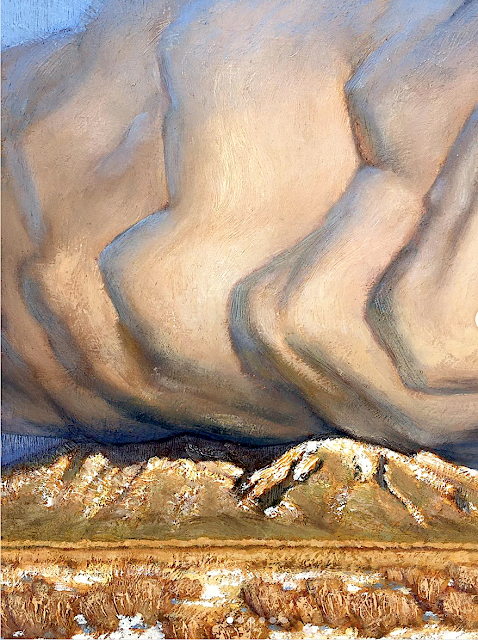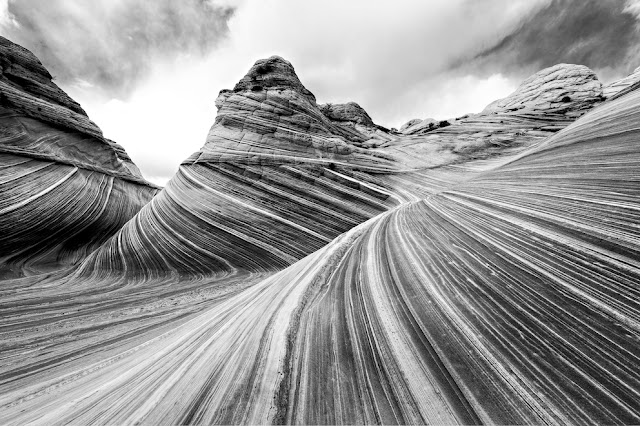SANFORD ROBINSON GIFFORD (1823-1880)
Cadillac Mountain (466 m - 1,530 ft)
United States of America (Maine)
In The Artist Sketching at Mount Desert, Maine, oil on canvas 1860s,
National Gallery of art, Washington DC
The mountain,
Cadillac Mountain (466 m-1,530 ft) is located on Mount Desert
Island, within Acadia National Park, in the U.S. state of Maine. Its
summit is the highest point in Hancock County and the highest within 25
miles (40 km) of the shoreline of the North American continent between
the Cape Breton Highlands, Nova Scotia and peaks in Mexico. It is known
as the first place in the U.S. to see the sunrise, although that is only
true for a portion of the year. Before being renamed in 1918, the
mountain had been called Green Mountain. The new name honors the French
explorer and adventurer Antoine Laumet de La Mothe, sieur de Cadillac.
In 1688, De la Mothe requested and received from the Governor of New
France a parcel of land in an area known as Donaquec which included part
of the Donaquec River (now the Union River) and the island of Mount
Desert in the present-day U.S. state of Maine. Antoine Laumet de La
Mothe, a shameless self-promoter who had already appropriated the "de la
Mothe" portion of his name from a local nobleman in his native Picardy,
thereafter referred to himself as
Antoine de la Mothe, sieur de Cadillac, Donaquec, and Mount Desert !
From 1883 until 1893 the Green Mountain Cog Railway ran to the summit
to take visitors to the Green Mountain Hotel. The hotel burned down in
1895 and the cog train was sold and moved to the Mount Washington Cog
Railway in New Hampshire
The painter
Sanford Robinson Gifford was born in Greenfield, New York and spent his
childhood in Hudson, New York, the son of an iron foundry owner. He
attended Brown University 1842-44, before leaving to study art in New
York City in 1845. He studied drawing, perspective and anatomy under the
direction of the British watercolorist and drawing-master, John Rubens
Smith. He also studied the human figure in anatomy classes at the
Crosby Street Medical college and took drawing classes at the National
Academy of Design. By 1847 he was sufficiently skilled at painting to
exhibit his first landscape at the National Academy and was elected an
associate in 1851, an academician in 1854. Thereafter Gifford devoted
himself to landscape painting, becoming one of the finest artists of the
early Hudson River School.
Like most Hudson River School artists, Gifford traveled extensively to
find scenic landscapes to sketch and paint. In addition to exploring New
England, upstate New York and New Jersey, Gifford made extensive trips
abroad. He first traveled to Europe from 1855 to 1857, to study European
art and sketch subjects for future paintings. During this trip Gifford
also met Albert Bierstadt and Worthington Whittredge.
In 1858, he traveled to Vermont, "apparently" with his friend and fellow
painter Jerome Thompson. Details of their visit were carried in the
contemporary Home Journal. Both artists submitted paintings of
Mount Mansfield, Vermont's tallest peak, to the National Academy of
Design's annual show in 1859. Thompson's work, "Belated Party on Mansfield Mountain" is now owned by the MET in New York, according to the report.
Thereafter, he served in the Union Army as a corporal in the 7th
Regiment of the New York Militia upon the outbreak of the Civil War. A
few of his canvases belonging to New York City's Seventh Regiment and
the Union League Club of New York are testament to that troubled time.
During the summer of 1867, Gifford spent most of his time painting on
the New Jersey coast, specifically at Sandy Hook and Long Branch,
according to an auction Web site.
Another journey, this time with Jervis McEntee and his wife, took him
across Europe in 1868. Leaving the McEntees behind, Gifford traveled to
the Middle East, including Egypt in 1869. Then in the summer of 1870
Gifford ventured to the Rocky Mountains in the western United States,
this time with Worthington Whittredge and John Frederick Kensett. At
least part of the 1870 travels were as part of a Hayden Expedition, led
by Ferdinand Vandeveer Hayden.
Returning to his studio in New York City, Gifford painted numerous major
landscapes from scenes he recorded on his travels. Gifford's method of
creating a work of art was similar to other Hudson River School artists.
He would first sketch rough, small works in oil paint from his
sketchbook pencil drawings. Those scenes he most favored he then
developed into small, finished paintings, then into larger, finished
paintings.
Gifford referred to the best of his landscapes as his "chief pictures".
Many of his chief pictures are characterized by a hazy atmosphere with
soft, suffuse sunlight. Gifford often painted a large body of water in
the foreground or middle distance (see above) in which the distant
landscape would be gently reflected. Examples of Gifford's "chief pictures" in museum collections today include: Lake Nemi (1856–57), Toledo Museum of Art, Toledo, Ohio ; The Wilderness (1861), Toledo Museum of Art, Toledo, Ohio ; A Passing Storm (1866), Wadsworth Atheneum, Hartford, Connecticut ; Ruins of the Parthenon (1880), Corcoran Gallery of Art, Washington, D.C.
On August 29, 1880, Gifford died in New York City, having been diagnosed
with malarial fever. The MET in New York City celebrated his life that
autumn with a memorial exhibition of 160 paintings. A catalog of his
work published shortly after his death recorded in excess of 700
paintings during his career.
_______________________________
2020 - Wandering Vertexes...
by Francis Rousseau

-%20Casthill%20Mountain%20House%20,%20The%204%20elements%201843-44.png)

-%20'Kilauea'.jpg)














